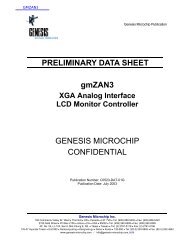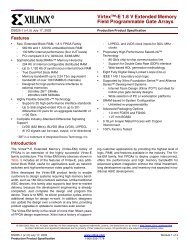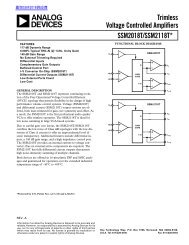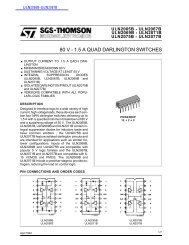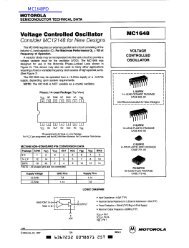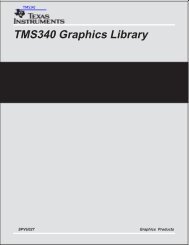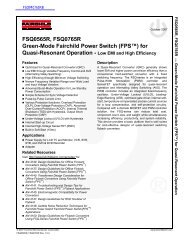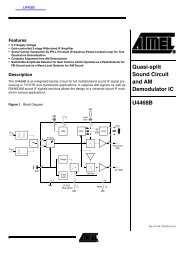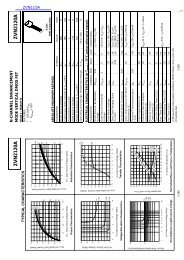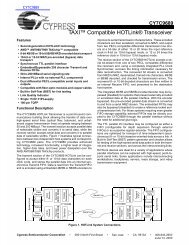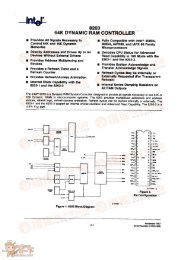You also want an ePaper? Increase the reach of your titles
YUMPU automatically turns print PDFs into web optimized ePapers that Google loves.
Table 26: Simultaneous Operations Allowed with the Protection Register<br />
Protection<br />
Register<br />
Read<br />
See<br />
Description<br />
Parameter<br />
Partition<br />
Array Data<br />
See<br />
Description<br />
Main<br />
Partitions<br />
Write/Erase<br />
Read Write/Erase<br />
Read Read Write/Erase<br />
Write<br />
No Access<br />
Allowed<br />
No Access<br />
Allowed<br />
Read<br />
Write/Erase Read<br />
13.2.1 Reading the Protection Register<br />
Numonyx <strong>Wireless</strong> <strong>Flash</strong> <strong>Memory</strong> (<strong>W30</strong>) (<strong>W30</strong>)<br />
Writing the Read Identifier command allows the protection register data to be read 16<br />
bits at a time from addresses shown in Table 20, “<strong>Flash</strong> Device Identification Codes” on<br />
page 55. The protection register is read from the Read Identifier command, and can be<br />
read in any partition.Writing the Read Array command returns the flash device to readarray<br />
mode.<br />
13.2.2 Programing the Protection Register<br />
Issue the Protection Program command only at the parameter partition followed by the<br />
data to be programmed at the specified location. This command programs the upper 64<br />
bits of the protection register 16 bits at a time. Table 20, “<strong>Flash</strong> Device Identification<br />
Codes” on page 55 shows allowable addresses. See also Figure 35, “Protection Register<br />
Programming Flowchart” on page 77. Issuing a Protection Program command outside<br />
the address space of the register results in a status register error (SR[4]=1).<br />
13.2.3 Locking the Protection Register<br />
Description<br />
While programming or erasing in a main partition, the protection register can<br />
be read from any other partition. Reading the parameter partition data is not<br />
allowed if the protection register is being read from addresses within the<br />
parameter partition.<br />
While programming or erasing in a main partition, read operations are allowed<br />
in the parameter partition. Accessing the protection registers from parameter<br />
partition addresses is not allowed.<br />
While programming or erasing in a main partition, read operations are allowed<br />
in the parameter partition. Accessing the protection registers is allowed, but<br />
only in a partition that is different from the partition being programmed or<br />
erased, and also different from the parameter partition.<br />
While programming the protection register, reads are allowed only in the other<br />
main partitions. Access to the parameter partition is not allowed, because<br />
programming of the protection register can occur only in the parameter<br />
partition, so that the parameter partition exists in status mode.<br />
While programming or erasing the parameter partition, reads of the protection<br />
registers are not allowed in any partition. Reads in other main partitions are<br />
supported.<br />
• PR-LK.0 is programmed to 0 by Numonyx to protect the unique flash device<br />
number.<br />
• PR-LK.1 can be programmed by the user to lock the user portion (upper 64 bits) of<br />
the protection register (See Figure 36, “Protection Register Locking). This bit is set<br />
using the Protection Program command to program a value of FFFDh into PR-LK.<br />
After PR-LK register bits are programmed (locked), the stored values in the protection<br />
register cannot be changed. Protection Program commands written to a locked section<br />
result in a status register error (SR[4]=1, SR[5]=1).<br />
Datasheet November 2007<br />
76 Order Number: 290702-13



